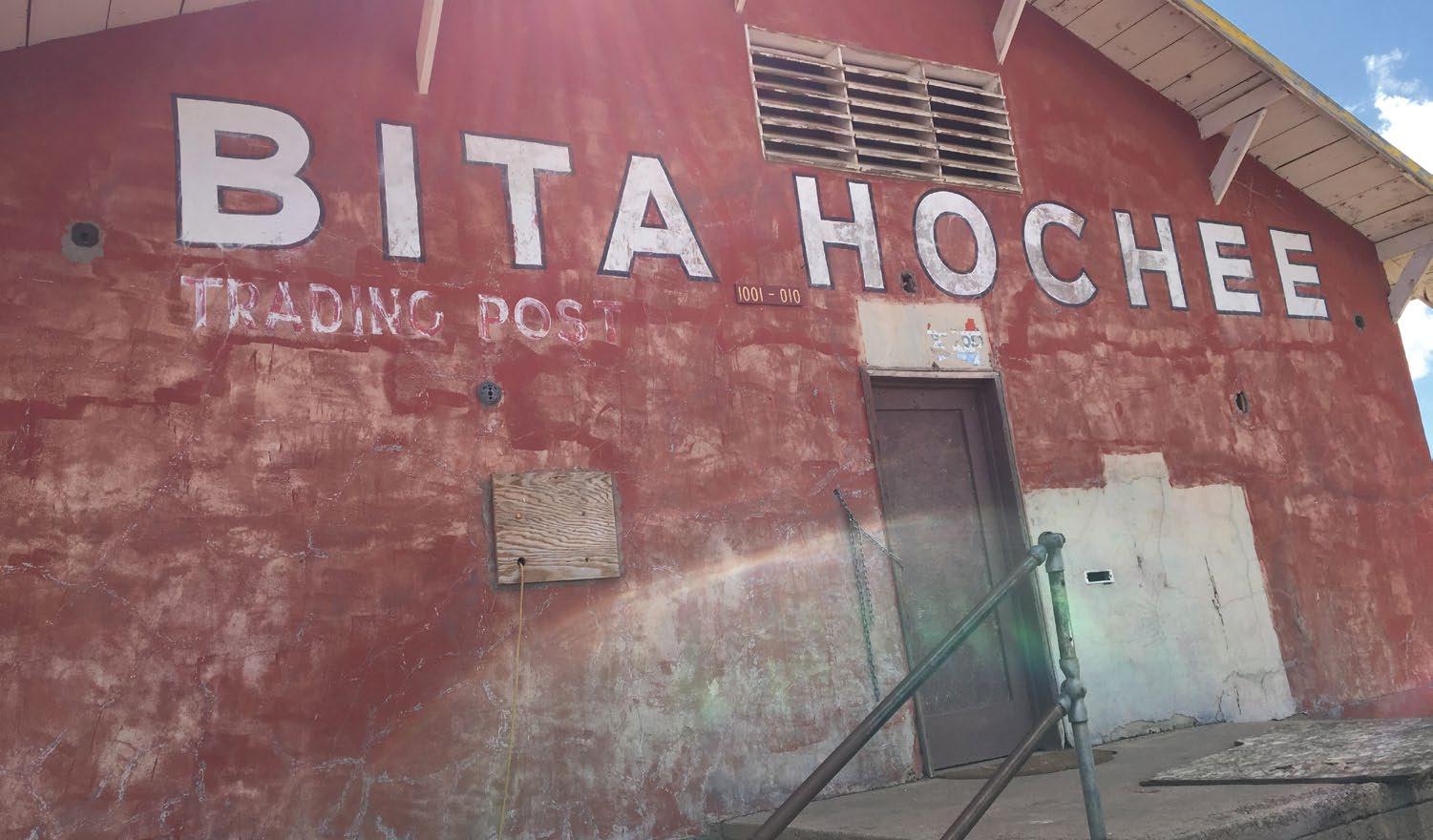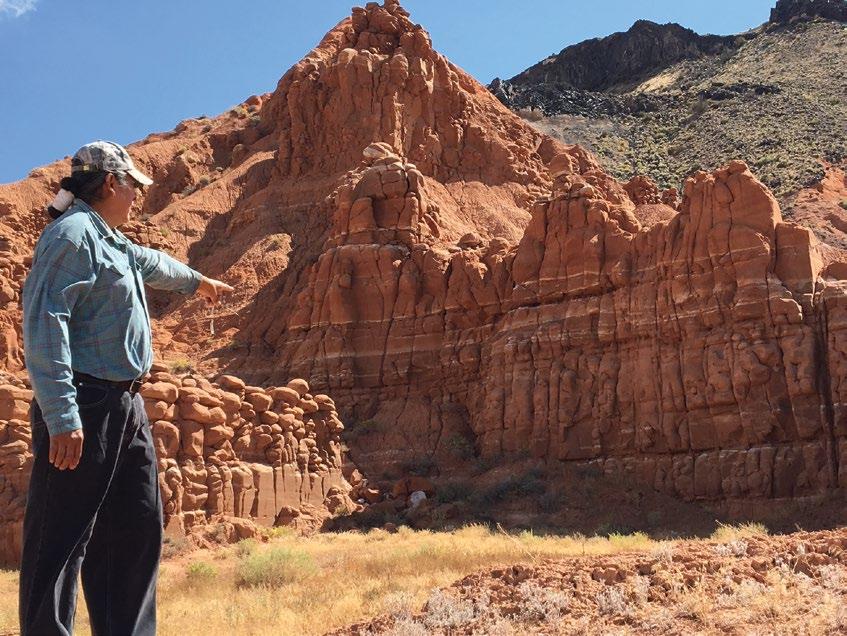
4 minute read
The Old Bita Hochee Trading Post: A “Time Capsule” From A By-Gone Era
By Tom Surface
The morning sun in the east warms the shoulders of the great trading post as it faces west, waiting for the start of the coming day’s buying and selling…. That was 1920 not 2020!
The former Bita Hochee Trading Post sits on eight acres of beautiful land at the base of a red rock butte (Bita Hochee is Diné (Navajo) meaning red rock running through).
In his studio, now part of the old trading post, renowned artist Redwing Ted Nez singlehandedly fought the tribal bureaucracy and won in his mission to restore the dilapidated site – formerly the heartbeat of economic and social activity for the southern area of the Navajo reservation. “Back then, the Bita Hochee Trading Post was like Walmart,” Redwing says. He knows intimately the red rocks and buttes that define this striking area. As a child, he ran sheep through a nearby pass and let them graze while he ran to Bita Hochee to buy an ice cream or soda.
Redwing’s goal in restoring the old Bita Hochee Trading Post is focused on preserving Navajo traditions and arts while creating a place where all people, especially the younger generations, can come to learn and enjoy Diné culture. “Bita Hochee is a “time capsule” of a by-gone way of life for our people. Our mission is to rekindle the interest of contemporary youth and the community in Diné heritage and culture,” Redwing states. The renovated site will serve as a non-profit artistic and cultural center where young and old can come together to teach, and learn from one another.”
A VITAL CROSSROADS AND GATHERING POINT
The Bita Hochee was first established in 1870 and functioned as a stagecoach station. Due to the tenuous relationship between the white man and the Indians at the time, small openings were built into the walls as gun ports. Ten years later it became a full-fledged trading post, and because of its location at the edge of the southern border of the reservation, it became known as the “Gateway to the Navajo Nation.”
The Bita Hochee became the place for the Navajo to gather to trade their wool, woven rugs, and other items for goods they could never acquire otherwise. The wares on the shelves of the Bita Hochee were both mystical and mesmerizing to the Navajo. Many Navajo children tasted their first hard candy here, traded for or occasionally given as a treat by the proprietor. The white traders were more than happy to deal with the Navajo. The quality of the wool, native crafts, blankets, pottery, and paintings made any trade a good one.

Bita Hochee Trading Post today. Sen. John Kennedy bought sodas and talked to local Diné from this porch. Inset: Redwing Nez in front of part of Bita Hochee being restored.
The Navajo would sometimes spend several days at the post bartering their wool or craft items, and socializing with other members of the tribe. Because of the vastness of the reservation, and the arduous mode of transportation (by horseback, wagon, or on foot), members of the tribe did not cross paths that often.
The Bita Hochee served as the departure point to basic training sites for area service members from World War II through Viet Nam. Even some of the famous Navajo Code Talkers departed by bus to Pacific combat destinations and history making, although the world wouldn’t realize their critical war contributions for more than 25 years. The grave of Theo Thysing, a U.S. Calvary soldier who became the first trading post operator in the 1880’s, also rests on the grounds behind the main buildings.
Although the management of the Bita Hochee Trading Post changed hands many times over the years, it remained a valuable connection for the Navajo Nation to the outside world. It was the local post office and medical facility and where local Diné gathered to get their Social Security checks. In the late 1950s, two “city slickers” from back east sat on the Bita Hochee’s porch buying soda pop for the locals while trying to convince them to vote “donkey instead of elephant.” According to local old-timers, those two politicians were Senator John F. Kennedy and his brother Bobby. Even Mercury 7 Astronaut Wally Schirra visited the old trading post after one of his journeys into space. Over time, convenience stores and the ability of people to travel to nearby towns to shop made the Bita Hochee obsolete. The Navajo tribe took over the Bita Hochee and closed it for good in 1994. It appeared that the post was destined to become a pile of crumbled stones and windblown memories.

Redwing Nez points to where an old sheep corral was located.
Fortunately, a mistake at tribal headquarters set the stage for saving the Bita Hochee.
The Bita Hochee was mistakenly flagged as a site where the Hanta virus was located. Later, a crew arrived with bulldozers prepared to destroy the trading post. Standing in their way was Redwing Ted Nez. Redwing parked his van at the entrance of the post, and refused to move. He knew the trading post was not a site of the Hanta virus. He had also grown up on the steps of the Bita Hochee. It had introduced him to many things in life, including his painting, and he knew how important it had been to his people. Redwing stood his ground. A few telephone calls later, the mistake was discovered, and the bulldozers were sent away.
BITA HOCHEE TODAY
Redwing started his campaign to save and restore the old trading post in 1999. His vision is to restore the original buildings as a cultural center includes a library with an historical archives and a study facility open to the public. Upon completing that phase of restoration, Redwing plans to petition for registration as a National Historic Site. Redwing and his non-profit organization and team have navigated a bureaucratic battlefield with a truckload of required documents to win approvals for renovations. It took years to clean out the old deserted buildings, remove asbestos, and dig up the old fuel tanks. Local volunteers pitched in to rebuild old structures with rocks from the hillside. A cattle guard is now in place. Electrical power is restored to the old wool storage building that also serves as Redwing’s studio. A water line from a nearby church and residence will be extended to the facility. An archeological research project insures that new construction and digging does not disturb any prehistoric sacred sites.
For more than 20 years, Redwing has remained relentless in his restoration mission. He appreciates all of the local and outside support he continues to receive. He welcomes visitors to stop by the trading post and his studio. Those interested can always arrange a visit or learn more by contacting him via e-mail at: bitahochee_paint@yahoo.com.



